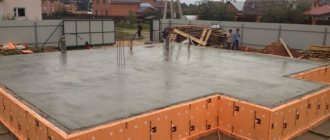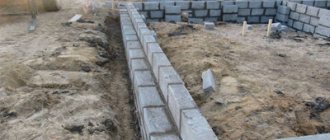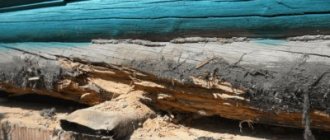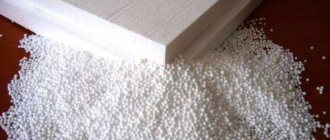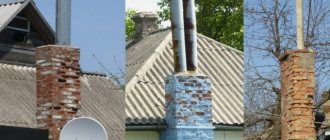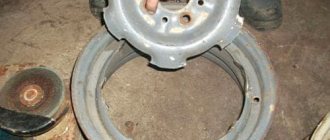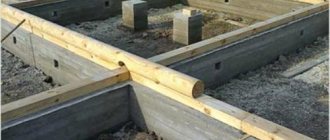Before building a house, geodetic surveys should be carried out to determine the nature of the soil, the depth of soil freezing, and the groundwater level. An unpleasant surprise for the developer is clay soil, which negatively perceives the effects of water. Due to the shallow occurrence of groundwater, the clay swells, destroying the base structure and causing cracks in the walls. Which clay foundation will maintain its integrity under load? Should I use a foundation on piles or is it better to give preference to a strip, column or slab structure?
Is it possible to build a reliable foundation for a house if the site has clay soil?
Clay soil consists of scaly elements prone to moisture accumulation.
A variety of heaving soils are clay, loam, and clay in combination with sand.
Clay, loam, and clay in combination with sand are a type of heaving soil characterized by an unpredictable character:
- dry clay soil is characterized by friability, which complicates the construction of a foundation on clay soil;
- waterlogged soil is susceptible to frost heaving, which gradually destroys the foundation on clay soil.
These factors negatively affect the strength characteristics of the foundation.
You should take seriously the choice of the optimal foundation option and pay special attention to the following factors:
- characteristics of clay soil. Sampling for laboratory research is carried out by making pits to the calculated depth. It is advisable to analyze samples in the spring months, when the moisture in the soil rises close to its surface;
- soil freezing level. Literary sources and professional websites provide information on the maximum possible depth of soil freezing in various regions, which makes it possible to determine the type and level of foundation depth;
The choice of the optimal foundation option should be taken seriously
- the proximity of aquifers and the ability of clay soil to absorb moisture. The depth of water layers is determined by drilling, and the tendency of clay to absorb moisture is determined in laboratory conditions. The samples are moistened and the drying time is subsequently monitored.
To determine the properties of clay soil, it is enough to make a series of pits in different places of the construction site, the depth of which reaches three meters.
Laboratory analysis of soil raised from various depths will provide a complete understanding of the characteristics and structure of clay soil, which is divided into the following types:
- clay soil. The concentration of pure clay reaches 1/3 of the total volume of soil. Such soil is characterized by increased flowability and high plasticity;
- loams. Along with 10% clay, such soils contain a sand fraction. Depending on the sand and clay content, they are divided into light, medium and heavy;
- sandy loam. The clay concentration does not exceed 1/5 of the total volume. Due to the increased concentration of sand, sandy loams are unsuitable for construction.
A laboratory analysis of soil raised from various depths will allow you to get a complete understanding of the characteristics and structure of clay soil.
Clay is divided into the following types:
- glacial. It has an increased load capacity and is suitable for the construction of foundations;
- alluvial. It is characterized by increased plasticity, which makes the construction of foundations difficult.
There is also red clay, which is water permeable. The foundations of buildings can be erected on it without any hindrance. Unlike red clay, blue clay retains moisture, which causes waterlogging in the soil in the foundation area.
Professional builders answer the question in the affirmative about the possibility of building a reliable foundation on a site with clay soil. It is important to choose the right type of foundation for the specific conditions of the construction site. If water layers are located close to each other and are above the freezing level, a drainage system should be installed before constructing the foundation. It will ensure effective removal of moisture from the base of the building.
Professional builders answer the question in the affirmative about the possibility of building a reliable foundation on a site with clay soil
Slab foundation
A slab is one of the most reliable types of foundation. Its main advantage is that it has a maximum base area, which means that even on loam with R about 1 kg/cm2 you can count on the absence of problems with the stability and shrinkage of the structure. At the same time, a slab foundation can be erected even with a high groundwater level and an impressive GGL. In winter, when the soil freezes, the foundation along with the house will rise, and when it warms up, it will fall. That is why it is also called a “floating” foundation.
How to choose the right foundation for clay soils?
When deciding which is best to build foundations for loamy soils, clay and sandy loam soils, consider the following factors:
- properties of clay soil at the construction site. The reduced moisture concentration makes it possible to construct a strip-type foundation that can withstand significant loads;
- uniform occurrence of clay at different horizons. In case of significant deviations of the soil at different levels, a foundation of a pile or pile-screw type should be constructed;
- level of location of aquifers. If groundwater is located close to the surface of the site, preference should be given to a solid slab or columnar base;
- the mass of the structure being built. With an increased weight of the building, it is advisable to give preference to a slab foundation, characterized by an increased area of the supporting surface;
- soil freezing level. With the close proximity of aquifers and an increased depth of soil freezing, the costs of constructing the foundation base increase and the labor intensity of the work increases;
- terrain features. The use of pile supports for the construction of a foundation makes it possible to reduce the labor intensity of work and increase the reliability of a foundation constructed on a sloping site.
All factors should be comprehensively analyzed when deciding on the type of foundation.
When deciding on the type of foundation, all factors should be analyzed comprehensively, including economic aspects. The most reliable, but expensive option is a slab base. It has proven itself positively on problematic soils. If there is a lack of financial resources, a pile foundation buried below the freezing level of the soil is suitable. When choosing between a strip and column foundation, you should take into account the properties of the soil and the structural features.
More information about each type of foundation
When you have a soil assessment in hand, you can begin to choose the type of foundation for your house. You also need to take into account the original plan of your building, your financial resources and labor capabilities.
Strip foundation
Scheme for building a foundation on loamy soil
This type of foundation is useful if the foundation of your house is brick. This makes the structure massive and heavy. And such a load must be supported by a stable frame. Therefore, by deepening it below the soil freezing line, you can get not only this, but also a full-fledged basement. In fact, an invaluable space includes storing food, laying out communication lines, etc. Such a foundation can be built monolithic, or it can be assembled from blocks (reinforced concrete). In the first case, the structure must be well reinforced to give it rigidity and strength.
Plate
A monolithic reinforced slab is an excellent solution to protect the house from loam heaving. It will protect it from distortion and cracks. It is installed even on very weak soils for houses, garages, bathhouses, gazebos and other buildings. It has a “floating” effect - when it swells, it rises and then returns to its original place. With it, the house is not afraid of groundwater that lies close to the surface.
The slab is poured into a dug pit. This is a reinforced monolithic structure. Its thickness may vary and is related to the planned weight of the house.
TISE piles
Increasingly, in individual construction, pile frames of the TISE type are used. This eliminated the need to make piles and transport them to the construction site. Yes, and driving them with a piledriver is also no longer necessary. For this, wells are dug in pre-selected places. Either iron or concrete pipes are inserted into them. Their diameter should be equal to the diameter of the future piles. They install a reinforced frame and fill it with concrete mixture. After drying, the iron pipes can be removed or left. In the second option, this will make the piles much stronger, but it will significantly increase their cost.
Special bends of reinforcement are left on top so that later they can be woven into the grillage reinforcement belt. This will provide greater structural strength.
Selection and construction of a foundation - which clay foundation is best
When determining which foundation is optimal for clay soils, one should take into account the characteristics and moisture content of the soil, as well as the concentration of clay and sand fractions in it. It is important to form a foundation that is resistant to deformation of clay soil, ensuring the durability of the structure.
Professionals advise constructing any of the following types of foundations for the future structure:
- tape;
- slab;
- pile;
- columnar.
For unstable soil with high moisture concentration, it is problematic to determine which option is better.
It is problematic to determine which option is better for unstable soil with high moisture concentration. To make a decision, you should comprehensively analyze all factors and focus on the results of geodetic surveys.
Strip foundation on clay soil
Strip foundations are often built on clay soils. It is characterized by increased strength, but is quite expensive and labor-intensive. The foundation, made in the form of a continuous reinforced concrete strip, ensures the stability of massive structures and light frame buildings.
Perform the construction of a strip foundation according to the following algorithm:
- Mark out the construction site according to the design documentation.
- Form the trench using an excavator or by hand.
- Assemble the formwork frame from wooden panels or other material.
- Form a cushion of sand and crushed stone and compact it thoroughly.
- Waterproof the inside of the trench using roofing felt.
- Assemble and place the reinforcement cage inside the formwork.
- Pour concrete solution into the formwork with the reinforcement frame.
- Compact the concrete mass using a surface or deep vibrator.
- Level the top plane of the foundation strip.
- After the concrete has hardened, lay the waterproofing material.
Using an excavator or by hand, form a trench.
By placing the bottom plane of the belt below the level of the aquifers, the foundation compensates for the reaction of the soil. This allows you to create a reliable foundation for the future building. To prevent deformation and shrinkage of the structure, the bottom sole of the tape should be 20% wider than the top part.
What's special about the soil?
It’s worth pointing out right away that loam is not something monotonous, as is often believed. Despite the absolute dominance of clay, the specific proportion of substances may vary. The higher the sand intrusion, the more pores appear and the lower the calculated soil resistance. In this case, they talk about soft plastic loams. Such soil is wet to the touch, it is easy to knead it, and then the rock retains its given shape.
Dry loams are predominantly crumbly. It has been established that this property is associated with the ingress of sand. The viscosity after wetting is due to the presence of clay. It also provokes freezing at certain temperatures and a sharp increase in volume. This combination of properties makes construction on loam not such a simple matter.
The proportion of clay, more specifically, ranges from 30 to 50%. Porosity can range from 0.5 to 1. The fewer the pores, the lower the likelihood of shrinkage and its severity. Water resistance is not guaranteed; wet loam is easily washed away.
The level of load-bearing capacity tends to change - when wet it decreases, when dry it increases.
Construction of a slab-type foundation - pour a monolithic slab on clay
A slab foundation is also called a floating foundation. When the soil moves, the solid slab moves with it, preventing deformation of the building and evenly distributing the load. Construction of a slab foundation is a costly undertaking. However, the slab provides increased stability of various buildings on problematic soils.
The procedure for constructing a floating foundation involves the following work:
- Marking the site for the foundation slab.
- Extraction of soil to a given depth.
- Construction of formwork around the perimeter of the foundation pit.
- Backfilling and compaction of crushed stone-sand cushion.
- Assembly and placement of the power grid inside the formwork.
- Pouring concrete and vibrating compaction.
A costly event - the construction of a slab foundation
The thickness of the slab is determined based on calculations. Such a foundation can withstand soil deformation and ensures the stability of any building.
Measures to reduce heaving in the area
Loam cannot be heated, because it contains clay, which makes it wet. And in the cold season, water expands when it freezes. Implementation of 5 measures will significantly reduce this indicator:
- A drainage system is formed along the entire perimeter of the building.
- Formation of the blind area of the building.
- Insulation of the blind area of the house.
- Installation of roof drainage and drainage system. Definitely going into the storm drain.
- Complete replacement of soil with a sand base before erecting the frame.
Watch a video on how to make soil drainage on your site:
Correct soil analysis and selection of the type of foundation based on it is the key to the long service life of your building. And even loamy soil is not a hindrance to this. Any of the proposed types of foundations is perfect for loam. But if you are not confident in your abilities, entrust this work to professionals. After all, you need to not only correctly determine what type of foundation you need, but also build it correctly for your house.
We construct a pile and pile-screw type foundation for clay soils
For clay soils, a pile or pile-screw foundation is also used. In the first case, the supports are driven into the soil using special equipment, and in the second, the piles are screwed into the ground. This type of foundation has a number of advantages. When installed, the supports reach solid layers of soil, which provide increased structural strength and are not subject to deformation when the soil freezes.
The following are used as supporting elements of a pile foundation:
- drilled type columns. They are created by drilling, followed by installation of reinforcing mesh and concreting;
- metal piles of a screw design. They are made of pipes with a special tip and screwed tightly into the ground;
- reinforced concrete elements. They are driven into the soil using special equipment and are used for massive buildings.
Pile or pile-screw foundation is also used for clay soils
The pile foundation effectively resists buoyant forces and has proven itself on soils with a high concentration of clay.
Advantages and disadvantages
The advantages of installing a strip foundation on loam include:
- high load-bearing capacity of the base, which can withstand heavy loads and allows you to build a building from almost any building material;
- durability of the foundation, amounting to 70-100 years, even when operating in unstable soil conditions;
- possibility of creating a basement.
There are also disadvantages:
- high labor intensity, requiring the efforts of several people and time;
- high costs for materials and high final cost of the foundation;
- cannot be used on soil with a high clay content. Ideal for building a house on loam.
How to build a columnar foundation on a plot of land with clay soil?
It is easy to build the base of a columnar structure with your own hands on an area with clay soil. The construction of a columnar foundation requires additional financial costs, which are offset by reliability and stability. A columnar base is constructed using various methods.
The first method involves performing work in the following order:
- Formation of cavities in the soil below the freezing level of the soil.
- Filling the base of the pit with crushed stone.
- Compaction of the formed crushed stone cushion.
- Lowering a metal or asbestos pipe into the cavity.
- Making a power grid from reinforcing wire.
- Placement of reinforcement cage in the pipe.
- Pouring concrete solution into the pipe cavity.
The formation of a columnar base using the second method is carried out according to the following algorithm:
- Marking the site.
- Remove the fertile soil layer.
- Square pits are made to a depth of 0.5-0.8 m.
- Cover the base with sand.
- Columnar supports are laid out from bricks or concrete blocks are installed on cement mortar.
The second option for constructing a columnar foundation is less expensive and easier to implement. The choice of method for constructing a columnar foundation is carried out individually, depending on the availability of materials, the mass of the structure, soil characteristics and financial capabilities.
Specifications
According to the fluidity index, GOST 25100-95 divides loams into:
- solid IL < 0;
- semi-solid 0 ≤ IL ≤0.25;
- rigid 0.25 < IL ≤ 0.5;
- soft plastic 0.5 < IL ≤ 0.75;
- fluid-plastic 0.75 < IL ≤ 1;
- fluid 1 < IL..
Basic properties:
| Characteristic | Unit | Index |
| Density | t/m³ | 0,21…0,24 |
| Conditional dynamic resistance | MPa | 0,36…0,67 |
| Porosity coefficient | e | 1,97-1,98 |
| Deformation modulus, E | MPa | 147 |
The density of loam may differ from that given. The parameter is mainly determined by terrain conditions:
- availability of groundwater;
- climatic features;
- various impurities in the total sample volume.
In damp swampy areas, significant soil compaction occurs; in dry areas, the soil is looser and more fertile, suitable for agriculture.
The specific gravity of loam depends on the density, its average value is 2.71 t/m³. This value is taken into account when calculating the bearing capacity of the foundation.
Another important property that is determined during geological research is the filtering capacity of soils. This parameter shows how quickly rainwater will leave the formation or, conversely, be retained in it. The filtration coefficient of loam is in the range of 0.005...0.4 m/day.
